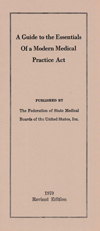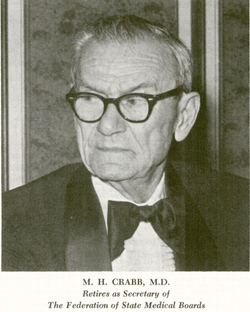 In 1956, the Federation released A Guide to the Essentials of a Modern Medical Practice Act. The Essentials provided recommendations in five core areas: the definition of the practice of medicine; eligibility standards for licensure; licensing examinations; licensure endorsement; and the bases for probation, suspension or revocation of a license. Since its initial publication, the Essentials has passed through twelve updated editions. Its purpose has been two-fold: (1) to guide states in revising their medical practice act and (2) to encourage the use of consistent standards, language and definitions. The Federation has periodically updated the Essentials, making it a living document for state board use as a template and tool in updating their state statutes or board's rules. Additional definitions have been added for key terms (e.g., competence, remediation, impairment) reflecting the dynamic nature of medical regulation.
In 1956, the Federation released A Guide to the Essentials of a Modern Medical Practice Act. The Essentials provided recommendations in five core areas: the definition of the practice of medicine; eligibility standards for licensure; licensing examinations; licensure endorsement; and the bases for probation, suspension or revocation of a license. Since its initial publication, the Essentials has passed through twelve updated editions. Its purpose has been two-fold: (1) to guide states in revising their medical practice act and (2) to encourage the use of consistent standards, language and definitions. The Federation has periodically updated the Essentials, making it a living document for state board use as a template and tool in updating their state statutes or board's rules. Additional definitions have been added for key terms (e.g., competence, remediation, impairment) reflecting the dynamic nature of medical regulation.
The original five core sections from the 1956 Essentials have been updated where appropriate. Elsewhere, new sections have been added, e.g., resident/limited licenses for physicians; impairment; compulsory reporting requirements; etc. A section on the structure and composition of state boards was also added. The Federation later developed a companion document: Elements of a Modern State Medical Board (1989).
International Medical Graduates (IMGs)
During the 1953-54 academic training year, more than 5,000 international medical graduates held intern or resident positions in the United States. These physicians presented a challenge in terms verification of credentials and drawing reasonable, informed conclusions as to the preparedness to treat patients. By 1949, 27 state boards were licensing interns and/or residents. Questions about access to, and qualification for, internship and residency positions fell squarely to state boards. State boards and other organizations looked to the Federation to see if a national solution would be forthcoming.
In 1954, the Federation proposed a central screening agency to evaluate credentials and assess preparedness before allowing IMGs to begin an internship and then sit for a licensing examination. The Federation, the AMA Council on Medical Education, the American Hospital Association and the Association of American Medical Colleges established a "Cooperating Committee" on Graduates of Foreign Medical Schools. The committee recommended that a separate organization be created to receive applications from IMGs, verify their credentials and administer a preliminary examination. Passage of the preliminary exam would allow them to enter into an internship and subsequently sit for a state licensing examination.
In 1956, the resulting organization was established: the Educational Commission for Foreign Medical Graduates (ECFMG). Since then more than 300,000 physicians have gained ECFMG certification allowing them to enter into graduate medical education in the United States. The value of the ECFMG has been reflected in the decision of all state medical boards to require its certification as a standard requirement of all IMGs seeking licensure.
The Federation's collaborative role in creating the ECFMG provided a second major success in the 1950's. With momentum building, the Federation next tackled perhaps its biggest challenge - bringing greater uniformity to state board examinations.
Examination Institutes - Collective Improvement in Assessment
In 1956, the Federation embarked upon perhaps its most ambitious initiative. State boards understood the growing deficiencies in their exams - e.g., too much content variation among states; outdated test items heavy on factual knowledge and recall; and scoring differences that created uneven standard for minimum performance. These differences hindered licensure endorsement.
 In 1956, FSMB President Dr. M. H. Crabb created a permanent committee to develop examination institutes for each of the major branches of medicine. The goal was to help state boards achieve greater uniformity in the content/quality of their exams. Each Institute would center on a different subject matter to create reports spelling out the assessment objectives for its given area. The most important idea derived from the Institutes was the concept of fitness to practice" or "fitness testing." State board exams would focus on the clinical application of medical knowledge with patient-centered questions. These would pose problems requiring physicians to transfer theoretical knowledge into diagnosis, treatment and patient management.
In 1956, FSMB President Dr. M. H. Crabb created a permanent committee to develop examination institutes for each of the major branches of medicine. The goal was to help state boards achieve greater uniformity in the content/quality of their exams. Each Institute would center on a different subject matter to create reports spelling out the assessment objectives for its given area. The most important idea derived from the Institutes was the concept of fitness to practice" or "fitness testing." State board exams would focus on the clinical application of medical knowledge with patient-centered questions. These would pose problems requiring physicians to transfer theoretical knowledge into diagnosis, treatment and patient management.
The Permanent Committee convened nine Institutes over a three year span and covering the following major areas: Anatomy; Physiology; Pharmacology; Biochemistry; Bacteriology; Pathology; Hygiene and Public Health; Surgery; Obstetrics and Gynecology; and Internal Medicine. The Institutes provided perhaps their greatest learning experience for individual state board examiners. They were required to think deeply about the content/construct of their exams and view them as dynamic instruments requiring boards to remain current in both medical knowledge and the emerging science of assessment.
The major initiatives of the 1950's signaled a resurgent Federation. These initiatives demonstrated the ability of the Federation to coordinate dialogue among the nation's medical boards, assist them in reaching consensus on major issues and then help implement changes that benefited the entire state-based system of licensure.

